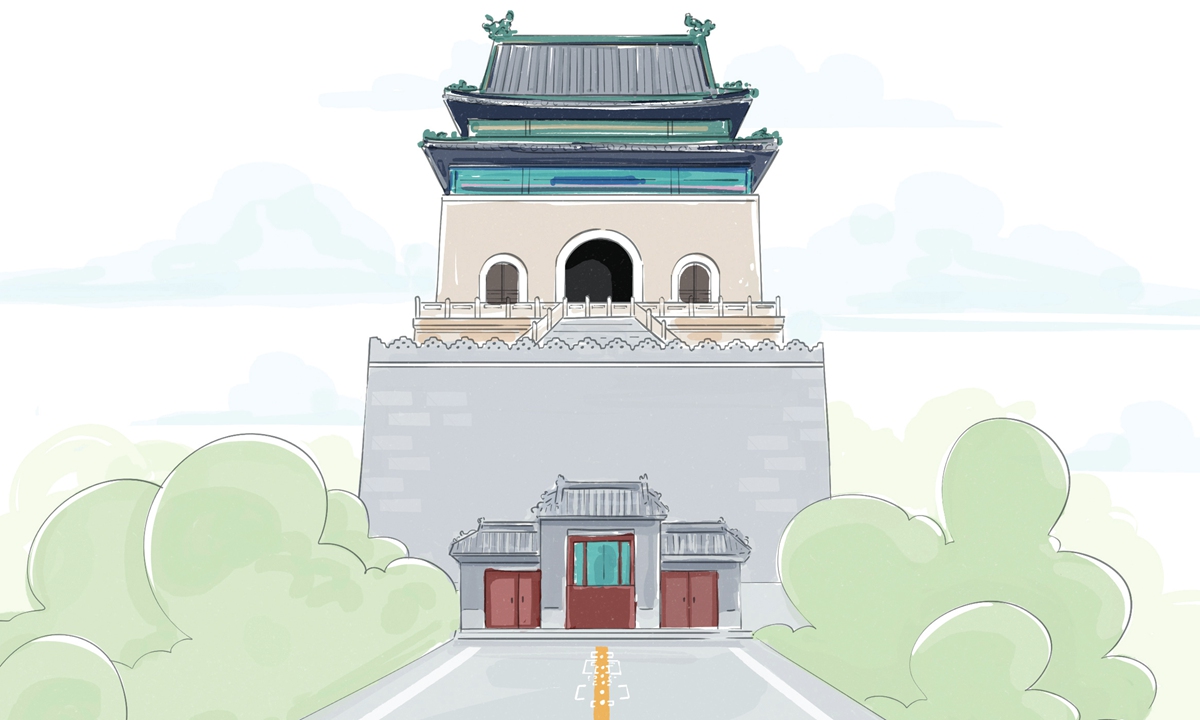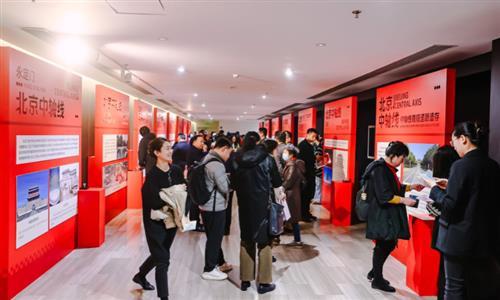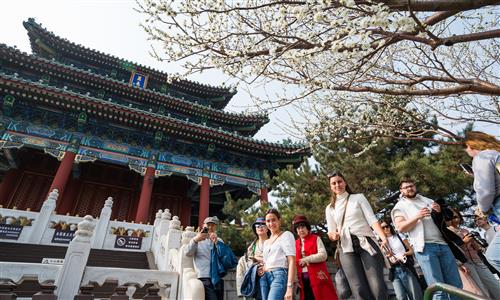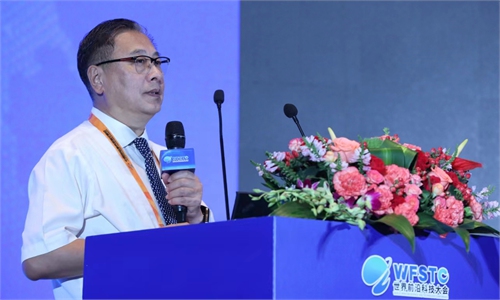LIFE / ATTITUDES
Beijing Central Axis more than cultural gem

Illustration: Chen Xia/Global Times
For anyone new to Beijing who wants to take a cultural journey across this ancient capital city, scenic spots including the Temple of Heaven, the Palace Museum, and the Drum and Bell towers are must-go destinations. Fortunately, there's a way to experience all of them and more - a cycling trip along the Beijing Central Axis.A crucial urban axis running through the capital from south to north, the 7.8-kilometer-long Central Axis connects dozens of the most popular historical and cultural landmarks that are outstanding representatives of ancient Chinese architecture.
Though several attractions along the axis have been included on the UNESCO World Heritage List, experts say that it is still important to include the axis as a whole, as the concept not only still influences modern Beijing's urban planning today but also reflects the unique philosophies behind ancient Chinese architecture and culture.
The 700-year-old axis was built back in the Yuan Dynasty (1279-1368), when Kublai Khan, grandson of Genghis Khan and ruler of the Mongol Empire, decided to move the capital to Beijing in 1264. Although construction was carried out during the time of an ethnic minority regime, the capital, however, was built in accordance with the Rites of Zhou, a book on organizational theory that dates back over 2,200 years.
The Records of Ritual and Music in the Rites of Zhou detailed the regulations for constructing a capital city: the court in the front, the market in the back, the ancestral shrines on the left, and the sacrificial altar on the right. Beijing was constructed following this layout, with the arrangement and functions of the city extending from both sides, all interconnected with the Central Axis.
Currently, the Beijing Central Axis is seeking to attain UNESCO World Heritage status at the World Heritage Committee this year. But that is not the ultimate goal. What comes along with the world heritage bid is the revival of long-deserted ancient architecture, the discovery of scattered history, the combination of ancient buildings and city development, and, of course, an attraction for global visitors.
On August 7, 2022, China's National Administration of Cultural Heritage announced that China would apply to have the Beijing Central Axis recognized as a UNESCO World Heritage site in 2024, 10 years ahead of initial estimates as the original application was previously set for 2035.
Since the initiation of the World Cultural Heritage application for Beijing's Central Axis, over 100 cultural heritage restoration projects have been gradually launched along the axis.
By the end of 2018, the architectural complex of the Shouhuang Palace in Jingshan Park reopened to the public after four years of restoration.
In October 2020, the restoration of Zhengyang Gate Arrow Tower in the southern part of the Central Axis was also launched. The restoration, including for the window lintels, interior wooden decorations, and roof structures, all adhered strictly to the original materials, forms, craftsmanship, and techniques used to build the tower, thus preserving its historical appearance to the fullest extent.
Standing proudly at the northern part of the Central Axis and overlooking the city's courtyard houses alongside the Drum Tower, the nearly 48-meter-high Bell Tower has been fully restored and has been open to the public since 2022.
The restored Bell Tower incorporated numerous modern facilities, and an immersive digital exhibition provides visitors with a whole picture of the history of the tower. The recently restored Hong'en Temple has been transformed into the "Beijing Central Axis Observation" museum, now open to the public by appointment. Inside the temple are digital art exhibitions and cultural spaces such as a library, post office, and a creative products store.
In March 2023, the 870th anniversary of Beijing becoming China's capital city was celebrated. An exhibition gave a full picture of the Central Axis with a 16-meter-long model of it for visitors to look at it from above.
During the second session of the 16th Beijing Municipal People's Congress on January 20, Yin Yong, mayor of Beijing, presented the Report on the Work of the Government, in which he mentioned that a three-year protective plan has been completed in accordance with the Beijing Central Axis UNESCO World Heritage Application.
He noted that a total of 15 heritage sites have been renovated, a move further promoting the protection of ancient architecture.
The Beijing Central Axis boasts both ceremonial and iconic buildings dating back to the 13th Century. These structures, with distinctive features, serve as exemplars of ancient Chinese architecture. When so many heritages come together, the complex becomes a story of Chinese civilization and the process of unity in Chinese history, as well as a concise overview of Chinese aesthetics.
As China recently extended its visa-free policy to more countries, with six new European countries such as Switzerland, Ireland and Hungary being included this time, the historical legacies are able to be seen by more tourists.
Looking ahead, the Beijing Central Axis can play a greater role in international exchanges, strengthening cooperation in areas such as cultural heritage preservation, joint archaeology and museum exhibitions.
In addition to imperial palaces like the Forbidden City, sites such as Qianmen Street and remnants of the Yongdingmen Royal Path serve as tangible history museums, offering visitors a glimpse into life seven centuries ago.
The historical neighborhoods and courtyard residences along the Beijing Central Axis showcase the historical charm of the ancient capital and embody unique urban memories, constituting invaluable folk culture resources. Through these folk culture resources, tourism projects can also be developed, such as traditional Beijing-style folk culture activities.
The author is a reporter with the Global Times. life@globaltimes.com.cn



